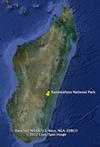
Environment, Poverty, and Human Health: an empirical analysis of ecosystem services for infectious disease regulation
Recent research has shown a relationship between two of the most pressing global problems. Deforestation contributes to the burden of infectious diseases. Deforestation by logging, agriculture, ranching, and so on, alters or fragments habitats to favor proliferation of pathogen-spreading vectors and environmental conditions such as soil temperature and moisture that favor pathogen survival. For example, land-use activities replace primary forest with cleared sites that are dominated by “weedy” secondary vegetation, which are preferred breeding sites for arthropods such as the Anopheles mosquito of malaria.
Moreover, removal of forest canopy affects the ability of soil to retain moisture and, thus infiltrate water into aquifers, which regulate flows to streams and rivers. Without ground infiltration or forest cover, a surface temperature increase can cause the soil to harden and rainwater runoff to carry sediment to clean waters. Insects prefer to deposit larvae in these turbid waters. Also, humans accessing these water sources, which may become contaminated with the sediment runoff, are at an increased risk of diarrheal diseases.
Furthermore, deforestation in species rich areas is strongly correlated with high losses of biodiversity. With a high level of biodiversity, there exist vector species that are not capable of transmitting pathogens to humans, thus diluting disease risk. One example includes incompetent snails involved in schistosomiasis transmission. Competency of a host is the ability to acquire infection with a pathogen. The transmission of schistosomiasis, which is an intestinal or urinary helminth infection, involves an infected human passing eggs through urine or feces into freshwater. Once in the water, the eggs hatch to find a freshwater snail intermediate host and are later re-released into freshwaters to come into contact and penetrate human skin.
On the other hand, with increased biodiversity, there are freshwater snails that the parasite penetrate, but does not result in infection in the snail (i.e. the parasite dies once infecting these incompetent snails). With these snails, there is a dilution effect in the number of parasites that further their lifecycle to go on to “re-infect” other humans that enter the freshwater sources.
Additionally, for reasons not clearly identified, deforestation results in the survival of generalist vectors that are better capable of transmitting pathogens to humans, surviving temperature changes, and covering large geographical areas.
The policy implications for conservation can have an important impact on the basic survival of forest edge communities. Locating susceptible humans next to ill-preserved, fragmented forests may increase infection risk. Anthropological disturbances or land alteration for human use reduces the geographic area of ecosystems and leaves small-unconnected patches of forest. The resulting habitat fragmentation reduces the forest edge buffer between humans and the sources of infectious disease.
Current efforts can benefit from new approaches to address this problem. There are no available vaccines for human parasitic diseases and pathogens also are building resistance to drugs. And, methods to predict the prevalence of diseases with vastly different ecologies are needed.
Combining forest conservation and human treatment can contribute to solutions for complex problems of disease control. If there is a common relationship between deforestation and infectious diseases, then with data on the prevalence of human infections, one can associate environmental indices of deforestation with the disease burden.
The added information of human health is a neglected area in conservation research. With more research on the effect of human health, the direct value of conservation can be understood for the communities that are affected by restricted access to forests.
My research seeks to collect data on schistosomiasis and malaria around the national park of Ranomafana, which has been conserved for more than 20 years, in Madagascar. The data will be associated with vegetation indices and other variables observed from aerial images and GIS data.
Madagascar has experienced one of the highest rates of deforestation in the world and, according to the human development index reports, is among the poorest countries globally. Intestinal schistosomiasis affects the forest-edge populations, but the prevalence varies greatly among villages. Taking into account the focal nature of schistosomiasis, which is dependent on available freshwater sources and the presence of intermediate snail hosts, our study seeks to assess if proximity to primary forest among other environmental health variables correlates or can predict schistosomiasis prevalence. Rapid diagnostic tests of circulating cathodic antigens, which detect for schistosomiasis, will be used to sample individuals within 50 to 60 villages. The study is not only a regional analysis of the association of conservation with disease prevalence, but also forms the preliminary work for longer-term studies that can monitor the rate of deforestation and emergence of disease.
Posted by Goylette Chami on Dec 14, 2012